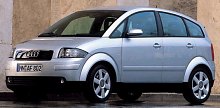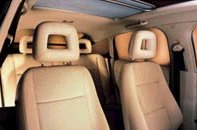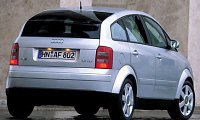 Undoubtedly,
A2 takes over A3’s role as the smallest car in Audi’s lineup. How small
is it ? given that the A3 is a rebodied Golf, the A2 must rival the
superminis
such as Fiat Punto and Toyota Yaris. According to dimensions, it is;
according
to price, it is not. It Germany, the 1.4 petrol A2 is priced at the
same
level as the cheapest A3, or 5% more expensive than Mercedes A140. Undoubtedly,
A2 takes over A3’s role as the smallest car in Audi’s lineup. How small
is it ? given that the A3 is a rebodied Golf, the A2 must rival the
superminis
such as Fiat Punto and Toyota Yaris. According to dimensions, it is;
according
to price, it is not. It Germany, the 1.4 petrol A2 is priced at the
same
level as the cheapest A3, or 5% more expensive than Mercedes A140.
The A2 has more or less the same overall length and width as the Fiat Punto. However, it is 70 mm higher but 50 mm shorter in wheelbase. The extraordinary height implies the adoption of sandwich structure platform - the concept first realised in Mercedes A-class. The engine is sandwiched between the floorpan and the driver's footwell, positioned in an inclined angle such that when a collision occurs, the engine and drivetrain will be pushed towards the road surface instead of the cabin. Therefore, unlike other tall cars such as Toyota Yaris, the Audi has a very high floor level and boost no extra headroom. However, the target arch-rival is Mercedes A-class instead of superminis, otherwise the high cost of Aluminium Space Frame chassis would not have been paid off. Compare with the A-class, Audi A2 seems rather conventional in dimension. It is 37 mm lower, 50 mm narrower but 245 mm longer, thanks to the outdated-looking front and rear overhangs. Because of the inferior width, the rear seat is heavily sculpted to accommodate two passengers, thus the A2 is strictly a 4-seater.
Audi claims the standard 1.4 petrol A2 weighs 895 kg while the turbo diesel version adds another 65 kg. Both of them are capable to do 0-60 in nearly 12 seconds. Base on these figures, I don’t think the Aluminium chassis worth the extra cost. Instead, an increment of 200 c.c. will be enough to cope with a conventional steel chassis and deliver much higher cost effectiveness. After all, Audi is so clever to use ASF as a strong selling point instead of any real technological advantage. Providing the sluggish performance is a range of petrol and diesel engines sourced from Volkswagen. The petrol four cylinder displaces 1390 c.c., with dohc 4 valves per cylinder and a maximum of 75 hp. Alternatively, 1.4 TDi provides a turbo diesel power plant with pump-activated direct injection, also output 75 hp but with a massive 144 lbft. Most special is not the engines but the engine compartment, which is sealed and provides no bonnet. Audi claims the engine is free of servicing for every 30,000 km, so access to the engine compartment is just needed at the aftersales workshop. Nevertheless, to enable refilling of oil and water, the pseudo grille, which is a black plastic cover with the 4-ring logo, can be opened to do that. The styling of A2 is perhaps the most brilliant aspect of the car and, in addition to the high-tech image of ASF, should be a strong driving force to sales. The compact body preserves the traditional high shoulder line of Audi. Sophisticated styling of the headlamps, grille, front bumpers looks classy, without looking similar to any other superminis. The bold wheel arches deliver a virtual effect that makes the small wheels look big, hence a sporting character. The swoopy roofline, although not good to rear passenger headroom, also distinguishes it from other cars. It provides a waterdrop shape which helps achieving the class-leading 0.28 Cd. To compensate the loss of rear visibility due to the dropped rear roof, the rear window becomes a two-piece item - the lower piece still locates at the tailgate, the upper piece is on the swoopy rear roof.
Visibility is not so good, thanks to the high shoulder and thick B-pillars, hence small windows. The location of A-pillars also block vision a lot. All passenger seats are detachable to load large goods such as bicycle, but unlike a real mini MPV, it doesn’t have other versatile facilities such as fold-table, seats-on-rail, parcel shelve and large storage cubbies. However, the boot is as big as 400 litres, and with a flat floor. The long rear overhang pays off here. On the road Despite of the sluggish performance figures, the A2 feels lively on road. The 1.4 petrol 16V is smooth and eager, this is further enhanced by the superb gearchange. Yes, Volkswagen used to make rubbery-and-heavy manual gearbox, but this one has none of those shortcomings. Good ratios aside, it shifts smoothly and precisely. In addition to the fluent clutch, the drive train is simply perfect. Handling is equally satisfying, although ride comfort suffers. Basically, Audi chose a very sporting setting for suspensions so to deal with the high center of gravity of the sandwich structure, hence limit body roll. This is the same technique Mercedes used to tame the elk-frightening A-class. However, Audi A2 has a better steering - a quick 2.9 turns lock-to-lock. This make the car feels agile and responsive at low speed. As speed increases, understeering digs in just like any other Audi, transforming the driving ambience from exciting to securing. Push it too hard, body rolls a lot and understeer dominates the whole picture, refusing to go any harder. It’s not a bad thing, considering the A2 is not designed as a GTi. After all, it is likely to spend most time in town at lower speed.
Of course, stiff suspension must result in compromised ride quality. Here is a paradox: while the A2 is not a GTi, it rides like a GTi. On the smooth Autobahn there is no problem, but in France and UK it is unlikely to shine. The high-speed-bias damping setup might also create problems for shock absorption on B-roads. Another problem is upgradability. Despite of the sporting setup, the A2 chassis is inherently a loser - high center of gravity and narrow. We have already seen its limit at high speed (which is further confirmed by the mandatory activation of ESP at above 43 mph, you can’t switch it off), so it is unlikely to introduce a high performance version matching Mercedes A190, let alone a real GTi. Moreover, the A2 can’t play lift-off oversteer at all, unlike a real GTi, it barely returns to neutral. Overall speaking,
the A2
is still a fun to drive car for most of the time. It definitely
eclipses
the Mercedes A-class in many ways, including handling. Build quality is
especially out of reach by others, not even the A3. Then there is a
sophisticated
ASF chassis to be proud of, and an interesting styling to look at. It
is
expensive, but cheap enough for those would like to have a taste of
prestige
and niche. Niche cars are usually rare, so Audi is going to shift just
60,000 cars per year. Not an economic scale, although some components
share
with Skoda Fabia. It would be lucky if Audi manage to generate profits
from it. |
| The above report was last updated on 5 Apr 2000. All Rights Reserved. |
 Highlight
is the ASF chassis. Because of the high production cost, ASF was
previously
limited to the A8 (and S8) only. Not even the A6 could afford the ASF.
Now Audi surprises us by introducing ASF to the smallest and cheapest
model.
Something has been done to lower the cost of this second generation
ASF,
such as using larger but fewer frames and involving fewer connection
nodes.
Laser welding is also extensively used in the bonding. The production
takes
place in the Neckarsulm plant, the home of A8.
Highlight
is the ASF chassis. Because of the high production cost, ASF was
previously
limited to the A8 (and S8) only. Not even the A6 could afford the ASF.
Now Audi surprises us by introducing ASF to the smallest and cheapest
model.
Something has been done to lower the cost of this second generation
ASF,
such as using larger but fewer frames and involving fewer connection
nodes.
Laser welding is also extensively used in the bonding. The production
takes
place in the Neckarsulm plant, the home of A8.
 Inside,
light-colored textile covers the cabin. The dashboard is rectangular,
simple
and with build quality to shame Mercedes A-class. You'll feel every
switch
gears and every piece of material fit firmly in position. The plastic
surface
has a substantial feel that not even found in a E430. That's always the
advantage of Audi. Space is remarkable for its size but not for its
price.
There's plenty of room in the front, especially the windshield is quite
forward. Headroom for the rear passenger isn’t as bad as the swoopy
roofline
suggest, although anyone exceeding 6 ft will find compromise. Rear foot
room is generous because the footwell is 150 mm lower than the floor
level
and extend towards the front seats. As a result, the passengers need
not
to pull up their knees, thus rest in a more natural position.
Inside,
light-colored textile covers the cabin. The dashboard is rectangular,
simple
and with build quality to shame Mercedes A-class. You'll feel every
switch
gears and every piece of material fit firmly in position. The plastic
surface
has a substantial feel that not even found in a E430. That's always the
advantage of Audi. Space is remarkable for its size but not for its
price.
There's plenty of room in the front, especially the windshield is quite
forward. Headroom for the rear passenger isn’t as bad as the swoopy
roofline
suggest, although anyone exceeding 6 ft will find compromise. Rear foot
room is generous because the footwell is 150 mm lower than the floor
level
and extend towards the front seats. As a result, the passengers need
not
to pull up their knees, thus rest in a more natural position.
 Steering
feel also worth praising. It feels natural, without the artificial feel
of most other Audi, while providing more feedback. Weighting is bias
towards
heavy, just matches the overall sporting character.
Steering
feel also worth praising. It feels natural, without the artificial feel
of most other Audi, while providing more feedback. Weighting is bias
towards
heavy, just matches the overall sporting character.